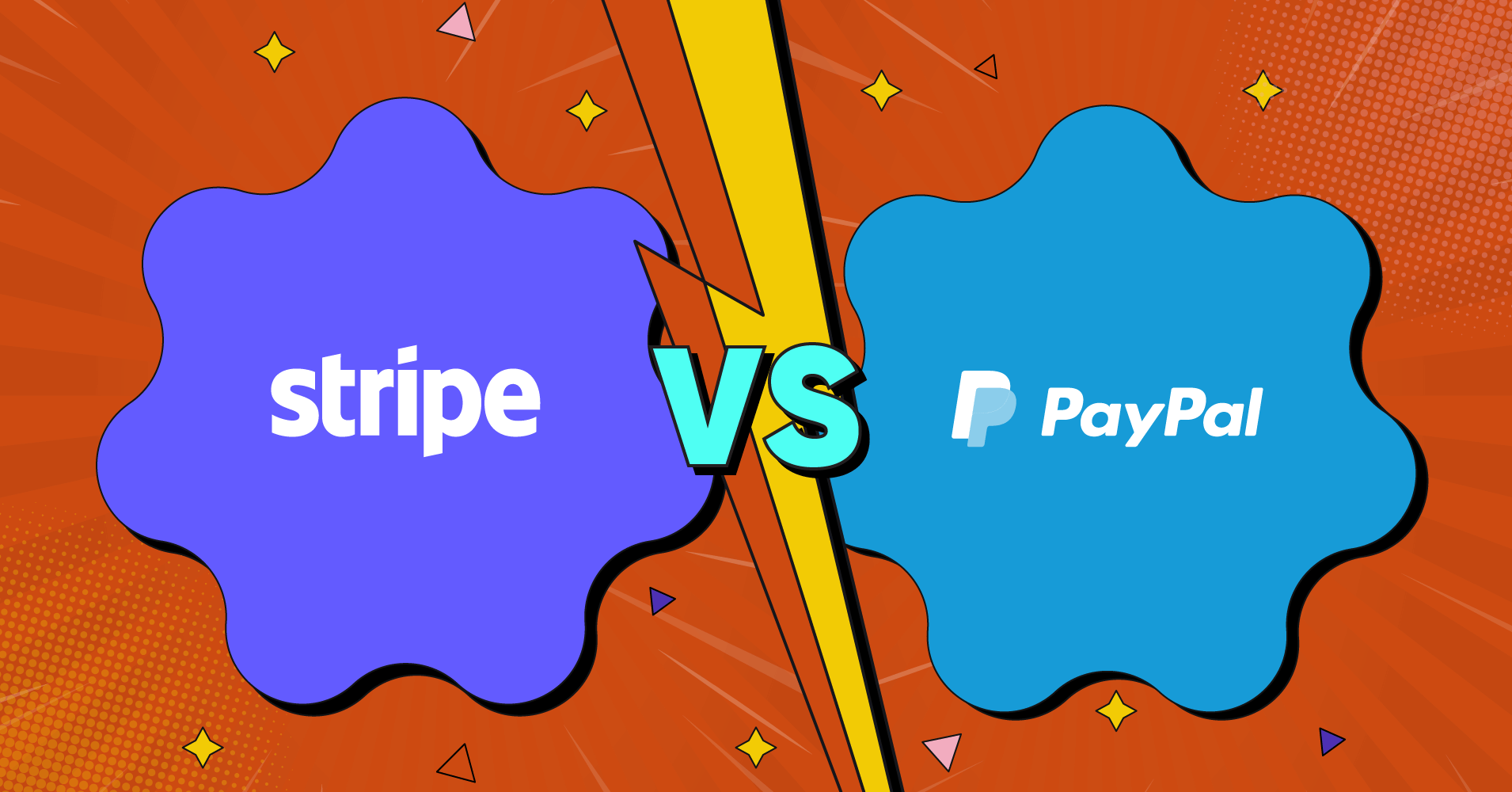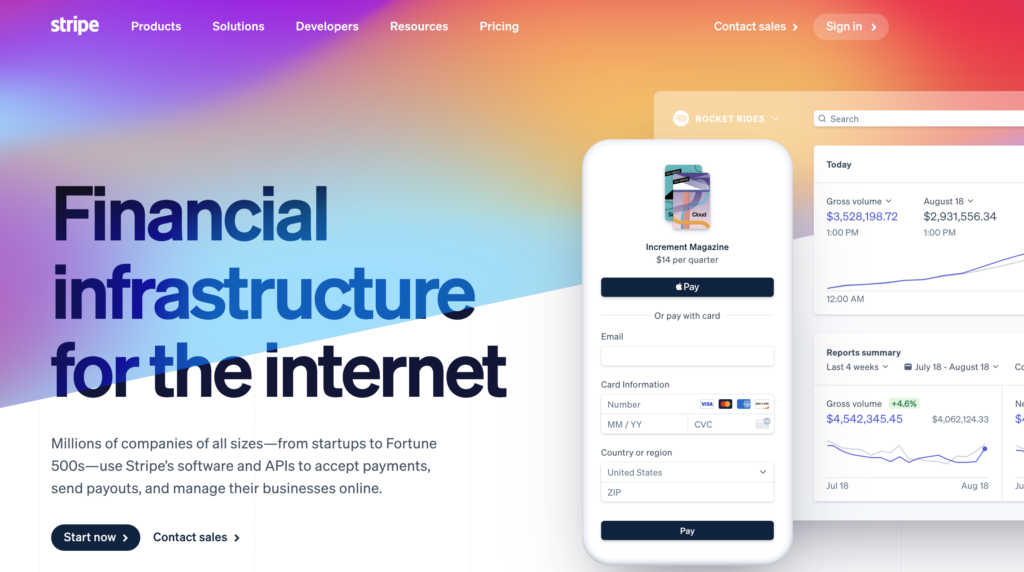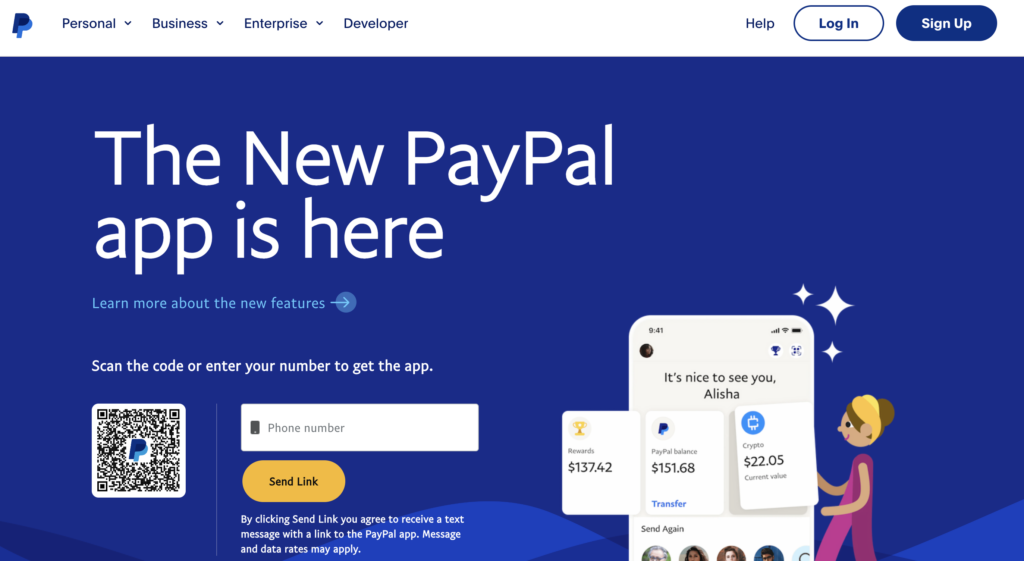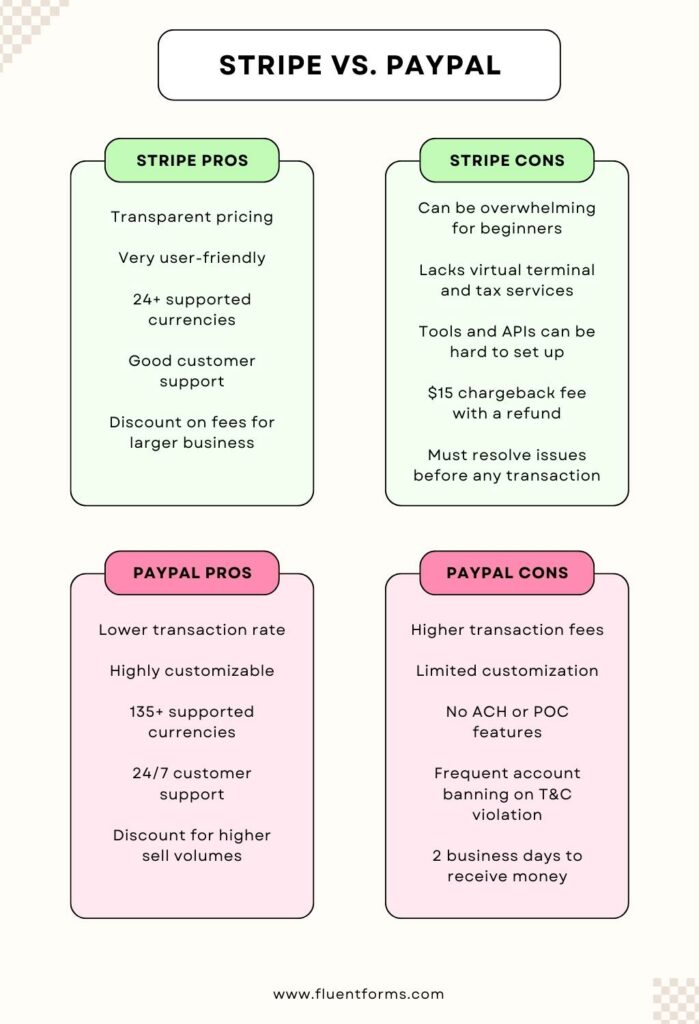Stripe vs. PayPal: Which is Better for Your Business

PayPal and Stripe are the two well-known powerhouses of payment service providers (PSPs). They both have some unique features of their own. If you’re after a fuss-free online transaction experience, PayPal might be your go-to. But if customization and flexibility are what you crave, then Stripe could be the perfect fit for you.
They’re basically a credit card processing service to process your customer’s payments seamlessly. If I simply put it, Stripe is a merchant services provider that allows customizing its solution for brick-and-mortar or online sales, whether PayPal is mainly a digital wallet.
To find out the differences between them and help you to decide which can is the better option, this Stripe vs PayPal head-to-head article got you all covered.
So, let’s buckle up and explore these two PSP giants!
What is Stripe?

Stripe is a financial services company that provides businesses with an online payment platform and tools for processing payments, managing subscriptions, and more.
The company was founded in 2010 and is based in San Francisco, California. It’s liked by code-savvy people as it offers different customizable development tools. For a certain fee, Stripe can aid your business in accepting payments through many different methods.
It’s a popular pick for SMEs (small to medium enterprises) but is also used by the giants like Pinterest, TaskRabbit, Lyft, etc.
Stripe integration with contact forms can simplify the process of payment collection for businesses of all sizes.
What is PayPal?

PayPal is also a well-recognized financial service company that primarily functions as a digital wallet for individuals or small businesses. PayPal claims to have over 400+ million customers account, including merchants.
As online transactions are increasing every day, nearly everyone has a PayPal account, and it’s one of the common names in the e-Commerece payment industry. PayPal is easy to use and secure and provides various services, including merchant services, money transfers, and payment processing.
Users can link their bank accounts and credit cards to their PayPal account and use it to safely make purchases online, pay bills, and even send money to friends and family.
For eCommerces it is also easy to collect payments via checkout forms with Paypal integration.
Stripe vs. PayPal
These two are the most recognized payment solutions that help collect money online. To collect funds from your site visitors through your website or for your personal transactions, you need a solid payment service provider for smooth financial offerings. If you want to know the difference between Stripe vs Paypal, stick to this article a little longer. We’ll discuss all their pros and cons and help you choose the best fit according to your need.
| Service Name | Stripe | PayPal |
|---|---|---|
| Contract Required | No | No |
| Online Transaction | 2.9% + $0.30 per transaction | 3.49% + $0.49 per transaction |
| Methods of Payments | Apple Pay, Microsoft Pay, Google Pay, Credit card and Debit card, and other foreign payment methods | Google Pay, ACH payments, Credit card, and Debit card, Pay in 4, Venmo, and then some |
| Invoice and Billing | Yes | Yes |
| Point-of-sale | Yes | Yes |
| E-commerce payment processing | Yes | Yes |
| API and Developer tools | Yes | Yes |
| Countries | Yes | Yes |
| Currencies | 135+ | 24+ |
| Customer Support | Excellent | Good |
| Suits for | Larger business with more sales | Smaller businesses with less sale volume |
Crucial considerations when choosing between Stripe vs. PayPal
There are a bunch of things you need to consider when you’re looking for the best solution for your payment systems. And as it’s a major decision, you need to look deeper into the things that matter the most:
Cost
The cost disparity between Stripe and PayPal can help you determine the right one for your business. PayPal charges 3.49% + 9 cents for manual entry card transactions and 3.49% + 49 cents for invoicing transactions, which is relatively higher compared to other similar companies in the industry. PayPal also has the lowest in-person transaction rate of 2.9% + 9 cents.
In contrast, Stripe maintains a consistent online processing rate of 2.9% + $0.30, applicable to both online and keyed transactions.
As you can see, Stripe is slightly more cost-effective than PayPal. In many cases, the slight cost differences may not have a significant impact. The primary distinguishing factors are the functionality and the features they offer.
Nevertheless, for businesses with a high sales volume, a slightly higher cost can accumulate into a lot of money at the end of a week or month. So, it’s something you should always keep in mind.
On the other hand, PayPal stands out with its lowest in-person transaction rate. So, if your business gets a lot of in-person sales, PayPal should be the go-to option. Although PayPal has the advantage of popularity, Stripe presents a range of advanced services at minimum costs.
Security
When it comes to safety, distinguishing between Stripe and PayPal can be quite a challenge at first glance. Rest assured, both companies hold the coveted PCI compliance certification, the gold standard for payment processors. Security of sensitive data and protection against fraud are top priorities for both Stripe and PayPal.
Now, let’s dive deeper into their security differences. While PayPal enjoys widespread familiarity and a positive reputation among users, Stripe shines in the realm of customer service. With a smaller user base, they can provide more personalized support.
When it comes to global reach, PayPal takes the lead, operating in a staggering 200 countries. This makes it a safer choice for businesses dealing with multiple countries. On the other hand, Stripe supports transactions in 47 countries but excels in handling a wide range of currencies—135 to be exact. PayPal, in comparison, supports 24 currencies.
Clearly, distinguishing between Stripe and PayPal is no easy task. But fret not, as we delve deeper, you’ll discover even more insightful information. So keep reading, because we’ve got your back!
Ease of use
Undoubtedly, PayPal is more user-friendly and easy to navigate than Stripe. While Stripe has a broader range of tools and complex functions, which also means it provides more versatility for users with the right knowledge. Although Paypal does offer some advanced features, it shines on simplicity.
If your business has high volume and less profit eCommerce sales, it’s worth choosing the complicated path, which means Stripe.
On the other hand, If your company has a healthy profit margin and lower sales volume, 3.49% + $0.49 transaction fee of PayPal may not be a significant concern to you.
So, in the debate between Stripe PayPal in terms of ease of use, PayPal receives a +1 point for its user-friendly interface.
Customer support
Let’s be realistic here; both companies claim to offer exceptional customer service, including live chat, email support, and more. However, in reality, no one can guarantee you instant customer service. For a clearer perspective, let’s compare the reviews of both companies’ customer service.
PayPal has an unbelievable rating of 1.3 stars on Trustpilot, a review-based website (based on 32000+ reviews). How could a company’s customer service get these many bad reviews? One logical explanation is that most people who submit reviews are customers who are unsatisfied with customer service. With approximately 223.3 million users, it’s no wonder they have difficulty maintaining quality customer service.
Stripe has 2.2 stars (based on 15400+ reviews) on the same website, which is quite better than PayPal. Stripe also has about 3 million users. So, your chances of receiving good customer service are generally better with Stripe than with PayPal. However, it is important to acknowledge that both companies try their best to serve their customers.
Availability
Services of PayPal and Stripe are available 24/7. However, when it comes to availability in different countries and currencies, there are some key points to consider.
Both companies are focused on international transactions, but they have differences. If your business requires working with a larger number of countries, PayPal should be the preferred choice as it operates in over 200 countries, while Stripe serves over 47 countries.
On the other hand, Stripe is ideal if you need to receive multiple currencies worldwide. Stripe is available in 135+ currencies, while PayPal supports 24+ currencies.
Online invoicing
An online invoice is a document generated by a payment gateway that includes sales information, pricing details, and the amount owed by a customer. Both PayPal and Stripe provide professional and user-friendly invoices. However, there is one difference between them in terms of invoice fees.
Stripe charges 0.4% as invoice fees in addition to any applicable transaction fee. On the other hand, PayPal adds the fee with their regular transaction fee, which means there are no separate fees for invoices.
Payment processing
When it comes to payment processing, a few players in the market often come up in conversations: Stripe and PayPal. Both companies offer various payment options and are used by many businesses. Still confused about choosing the right one?
Let’s look at some of the major differences between the two services to help you decide which is the best for your business.
PayPal fees vs Stripe fees
Both PayPal and Stripe are very transparent about their fees. But sometimes, for newcomers, it might get confusing.
Stripe and PayPal are considered leaders in the online payment industry but have some key differences. Stripe’s fee for swipe and chip transactions starts at 2.9% plus 9 cents, while PayPal’s is 2.29% plus 49 cents. PayPal’s fee for keyed transactions is higher, starting at 3.49% plus 9 cents, while Stripe’s fee remains the same. Both companies also have chargeback fees, with PayPal charging $20 and Stripe charging $15.
Additionally, PayPal charges an extra 1.50% for international transactions, while Stripe charges an extra 1.5% for international cards and 1% for currency conversion. Neither company refunds the transaction fee when a customer issues a return. Stripe is best suited for creating a customizable checkout flow, but this requires developer knowledge. PayPal, on the other hand, is easy to set up and better suited for smaller businesses.
In summary, Stripe charges a flat rate for transactions, while PayPal’s fees vary depending on the type of card and how the payment is made.
RADAR fees
Stripe imposes a RADAR fee of 5 cents ¢ for every transaction attempt, regardless of whether the payment is successful. For instance, if a user enters an incorrect expiry date, you will be charged a RADAR fee for that attempt and an additional fee for any subsequent attempts. Standard accounts are exempt from this fee, but nonprofit organizations are subject to RADAR fees.
Stripe vs. PayPal: Pros & Cons
Let’s be honest no one can remember everything they just read. To make it easy for you we summarize the pros and cons of Stripe vs. PayPal to help you make an optimal decision.

Stripe pros:
- Lowest online processing rate; 2.9% + $0.30 flat rate for each eCommerce transaction.
- High customizability and provides lots of developer options for most business purposes.
- Supports 135+ currencies and 47+ countries.
- Easier to reach customer service, 24/7 service via live chat, phone, and Email.
- Businesses can get discounts for higher sell volumes.
- No charge for setup, account maintenance, or cancelation.
Stripe cons:
- Higher customizability can be overwhelming for beginners, although it has some straightforward options.
- Tools and APIs can be hard to set up without coding expertise.
- Lacks virtual terminal and tax services.
- You must resolve any issues with your account before any transaction.
- $15 chargeback fee with a refund if you process an inappropriate transaction. (PayPal has a $20 chargeback fee)
PayPal pros:
- Transparent pricing, with a flat rate of 2.29% + 9 cents for in-person and QR code transactions, 3.49% + 9 cents for manual entry card transactions, and 3.49% + 49 cents for invoicing transactions.
- Easy to use, making it a good option for small business owners who prefer a simple setup process.
- International support, accepting around two dozen currencies.
- Strong customer support, with phone support available Monday through Friday and additional options such as text support, an online community, and a resolution center for transaction or account issues. Response time may vary because of their larger user base.
- Provides discount on transaction fees for larger businesses.
PayPal cons:
- Compared to Stripe, PayPal has higher transaction fees per transaction.
- Limited customization options with a cut-and-paste implementation approach may not be suitable for businesses that require detailed customization.
- Does not have an ACH payment option or POS features.
- Not suitable for businesses with high sell volume, as PayPal charges higher fees per transaction.
- Violation of Terms and Conditions can freeze your account for months.
- Usually takes 2 business days to receive money.
Stripe vs. PayPal: safety aspects
Both Stripe and PayPal have top-class security systems, ensuring a safe commercial environment for the customers. Let’s dive in and find out more.
Is Stripe safe?
Stripe prioritizes the greatest level of security to provide a safe and dependable environment for its consumers. It is happy to be a PCI Service Provider Level 1 certified company. To attain this level of security, they had to maintain exceptional safety in all aspects of their service. Here are some significant features of their security products.
- Stripe has a robust mechanism in place to safeguard sensitive data. Stripe’s internal systems, which are encrypted using AES-256, are also unable to access card information in plain text.
- Every website that uses Stripe services must use TLS, which ensures that all information passed across the platform is encrypted and secure.
- Stripe also handles incorrect transactions swiftly and takes the required steps to rectify them.
Is PayPal safe?
PayPal is also PCI-compliant, and customers can use PayPal services safely without hesitation. As a leading payment processing service provider, they maintain safety with various security tools to protect their customers from hackers and fraud. Here are some steps they implemented to ensure the safety of their service.
- All the financial details are kept safe with utmost care. Recipients will not get any sensitive information like bank account numbers, card numbers, or account balances.
- PayPal safeguards their customer through PayPal Purchase Protection, which means customers can request a full refund if they do not get the desired service or encounter issues with a seller.
- PayPal also protects sellers through PayPal Seller Protection. Buyers and sellers can make claims with proper evidence in case of complications.
Enjoying this article?
We regularly publish actionable content on our blog. Subscribe to get them delivered straight to your inbox.
We won’t spam you. You can unsubscribe whenever you want.
Takeaways
Stripe and PayPal offer similar payment transfer services while striving to meet various consumer objectives. When deciding between Stripe and PayPal, organizations should assess their individual needs and priorities.
PayPal is user-friendly and simple to set up, making it an excellent alternative for businesses seeking simplicity. Stripe excels at adaptability, but it requires a professional to set up and use it properly. Strip offers a lower online transaction fee than PayPal, but PayPal has a lower in-person transaction fee.
Stripe will assist the firm with a big consumer volume in general. PayPal, on the other hand, is great for businesses looking for simplicity and lower-cost in-person transactions.







Leave a Reply